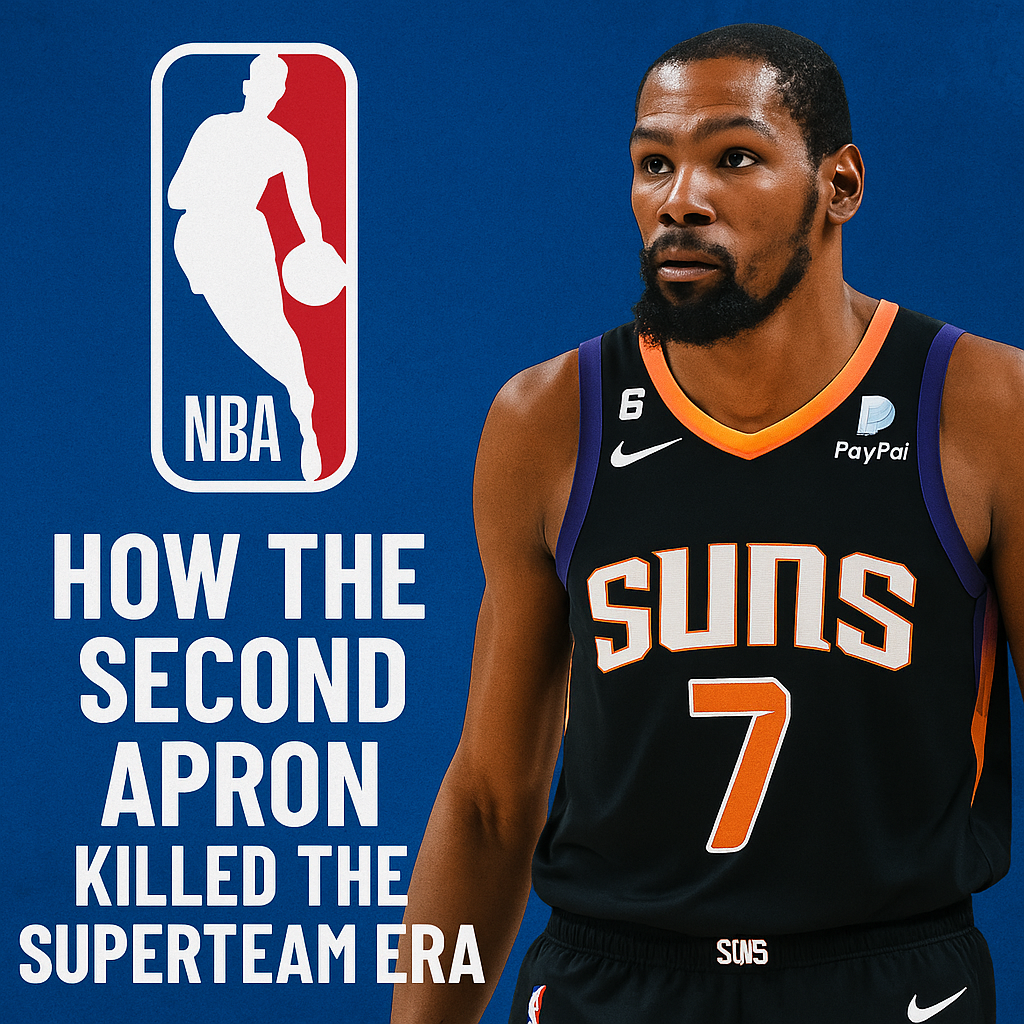The NBA season is winding down, which means one thing: it’s about to get absolutely wild in front offices across the league. While you’re watching highlights and playoff drama, team executives are already plotting their next moves in a chess match that’s become more complex than ever.
Listen to this article:
If you’ve been hearing about the “second apron” and wondering what the hell everyone’s talking about, or why your favorite team can’t just sign that free agent you want – this is for you. The NBA’s salary cap system has become a labyrinth that even some GMs struggle to navigate, but understanding the basics will make you appreciate the chess moves happening behind the scenes.
The Foundation: How the NBA Salary Cap Actually Works
Unlike the NFL’s hard salary cap, the NBA operates with a soft salary cap system. Think of it as more of a suggestion than a rule – teams can go over it, but there are consequences.
For the 2024-25 season, the salary cap sits at approximately $140.6 million. But here’s where it gets interesting: teams routinely spend way more than this. How? Through a series of exceptions and rules that would make a tax attorney’s head spin.
The real financial pain starts at the luxury tax line (around $170.8 million), where teams pay dollar-for-dollar penalties on every cent they spend over. Miss the playoffs while paying luxury tax? That’s when owners start making phone calls that end careers.
The Apron System: Where Things Get Serious
The NBA introduced two new thresholds that have completely changed how teams operate:
First Apron ($178.1 million)
Cross this line and your team faces significant restrictions:
- Mid-level exception gets cut to $5 million max
- Can’t receive players in sign-and-trade deals
- Limited ability to package multiple players in trades
Second Apron ($188.9 million)
This is the danger zone. Teams above this threshold are essentially handcuffed:
- No mid-level exception at all
- Cannot trade away more salary than you take back
- No bi-annual exception
- Stay here multiple years? Kiss future draft picks goodbye
The Tools Teams Use to Build Rosters
Bird Rights are your best friend as a GM. Named after Larry Bird (naturally), these rights let you re-sign your own players even if it puts you over the cap. No salary limit, no restrictions – just pure loyalty rewarded.
Mid-Level Exception is like finding money in your couch cushions. Even over-the-cap teams get to sign free agents, with amounts varying based on your tax situation. Non-taxpayers get about $12.4 million to play with, while taxpayers get roughly $7.5 million.
Trade Exceptions are created when you trade away more salary than you receive. Think of it as a credit you can use later to absorb contracts in future deals.
What’s About to Happen This Offseason
As teams gear up for the 2025 offseason, the new apron rules are forcing unprecedented strategic thinking. Here’s what to watch for:
Salary Dumps Everywhere: Teams approaching the second apron will start trading veterans for nothing just to create breathing room. Don’t be surprised to see productive players moved for second-round picks or cash.
Creative Contract Structures: Expect more player options, team options, and backloaded deals as teams try to maximize flexibility while managing apron thresholds.
The Middle Class Squeeze: Mid-tier free agents (think $8-15 million annually) will find fewer suitors as teams either go cheap or spend big, with little room for in-between moves.
Team Spotlights: Who’s in Trouble?
Phoenix Suns: Trapped in Paradise
The Suns are the poster child for second apron problems. With Durant, Booker, and Beal eating up over $150 million combined, Phoenix can basically only sign players for the minimum wage. They’ve turned their franchise into a championship-or-bust situation with zero flexibility.
Their offseason strategy? Hope their current roster works because they literally cannot make meaningful changes.
New York Knicks: Walking the Tightrope
After trading for Mikal Bridges, the Knicks are dancing dangerously close to apron territory. They’ll need to be surgical with any moves, potentially trading rotation players just to maintain flexibility.
Expect the Knicks to get creative with minimum contracts and hunt for undervalued veterans willing to chase a ring in the Big Apple.
Golden State Warriors: The Veteran Dilemma
With aging stars and massive contracts, Golden State faces difficult decisions. Do they pay luxury tax penalties to keep their championship core together, or start making the hard choices that signal the end of an era?
What This Means for Fans
Understanding these rules helps explain why your team makes moves that seem crazy on the surface. When the Lakers trade a fan favorite for a protected second-round pick, it might not be about basketball talent – it could be about avoiding $50 million in luxury tax penalties.
For Small Market Teams: The apron system actually helps level the playing field somewhat. Big-spending teams face real consequences for going overboard, creating opportunities for smarter, more efficient roster construction.
For Superteams: The days of simply buying championships are over. Even the wealthiest owners must think twice about assembling multiple max contract players due to the restrictions that come with extreme spending.
How This Impacts Players: The New Reality
The second apron isn’t just changing how teams operate – it’s fundamentally altering player careers and earning potential across the league.
The Superstar Squeeze
Max players are becoming roster anchors – and not in a good way. When you’re paying three guys $50+ million each, the math simply doesn’t work anymore. Teams are thinking twice about trading for superstars, knowing they might get locked into financial purgatory.
Look at Bradley Beal’s situation in Phoenix. His no-trade clause and massive contract make him virtually unmovable, even if the fit isn’t perfect. Superstars now need to be more strategic about their destinations because teams can’t easily course-correct if things go wrong.
The Middle Class Gets Squeezed
The $8-20 million player is an endangered species. Teams are either going all-in on max contracts or hunting for bargains. The solid veteran making $15 million annually? He might find himself priced out as teams choose between paying luxury tax penalties or filling that roster spot with three minimum guys.
This creates a brutal reality: you’re either a max player or you’re fighting for scraps.
Veteran Minimum Gold Rush
Ring-chasing has never been more lucrative – if you’re willing to play for peanuts. Contending teams above the apron can only add talent through minimum contracts, creating unprecedented opportunities for savvy veterans.
Expect more former All-Stars taking minimum deals to join contenders, knowing they’re the only pathway for talent acquisition on restricted rosters.
Young Players Win Big
Rookie contracts are now pure gold. Teams are desperately seeking cost-controlled talent, making draft picks and young players more valuable than ever. Don’t be surprised to see teams overpaying in trades just to acquire players on rookie deals.
The CBA changes have essentially created a two-tier system: max contract superstars and everyone else fighting for whatever’s left.
Trade Demands and Player Power
Player empowerment just got complicated. Superstars can still force trades, but their destinations are now limited by apron math. If only three teams can afford your contract without destroying their flexibility, your leverage just decreased significantly.
The Death of the Superteam
Remember the 2017 Warriors adding Kevin Durant? The Big Three era in Miami? Those days are officially over.
The second apron makes it nearly impossible to assemble more than two max players without completely gutting your depth. Even if you manage it, you’re stuck with that core and zero flexibility to make adjustments.
The Suns tried to buck this trend by trading for Beal after already having Durant and Booker. The result? A roster with zero depth and no way to improve it. They’re living proof that the superteam era is dead.
What Replaces Superteams?
The new championship model focuses on two max players surrounded by perfectly constructed role players and young talent. Think more Denver Nuggets (Jokic + Murray + smart depth) and less Brooklyn Nets (Durant + Irving + Harden disaster).
Teams are realizing that roster balance beats star power in this new financial landscape. You need stars, but you also need the flexibility to surround them with complementary pieces.
The Bottom Line
The second apron has fundamentally restructured the NBA’s ecosystem. Superteams are extinct, middle-class players are endangered, and smart roster construction matters more than ever.
For players, this means career planning is more crucial than ever. Where you sign, when you sign, and for how much can determine not just your individual success, but your team’s championship window.
For teams, the message is clear: get smart or get stuck. The organizations that master this new system will dominate the next decade, while those clinging to old strategies will find themselves trapped in mediocrity.
The superteam era gave us incredible basketball, but it’s time for something new. Welcome to the age of strategic roster building, where every dollar matters and every move has consequences that ripple for years.
Buckle up – this new NBA is going to be fascinating to watch unfold.
Stay tuned to HoopWRLD for all the latest NBA offseason moves and analysis as teams navigate the complex world of salary caps, aprons, and championship dreams.





